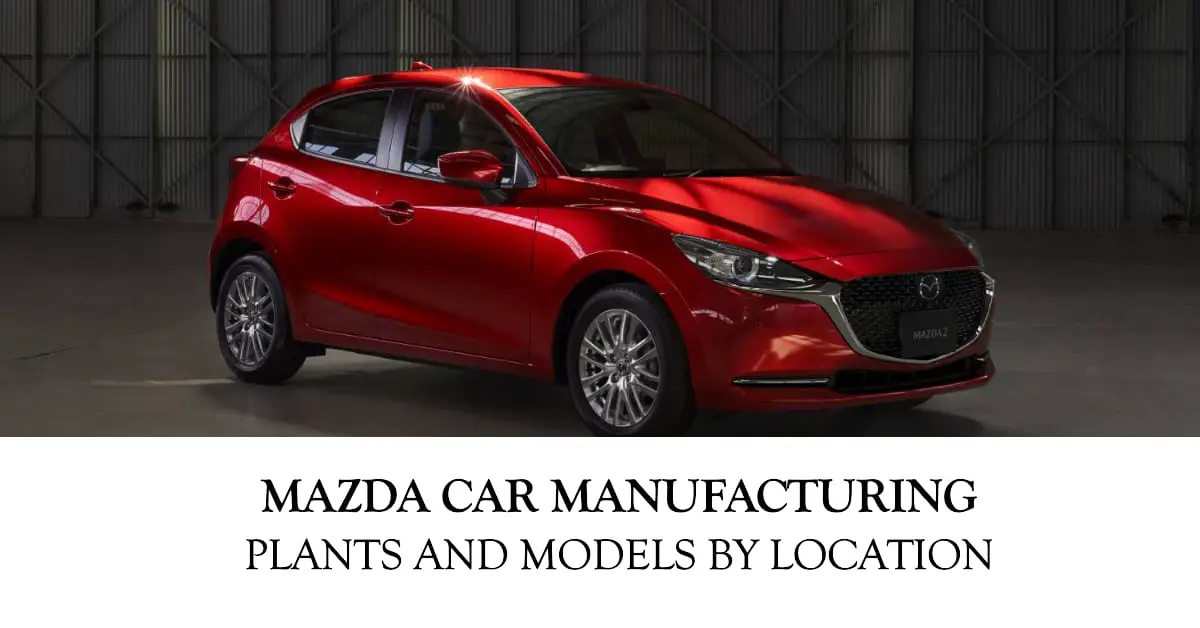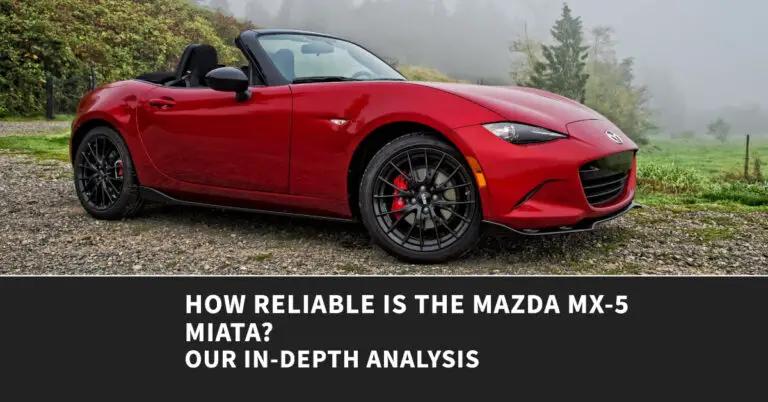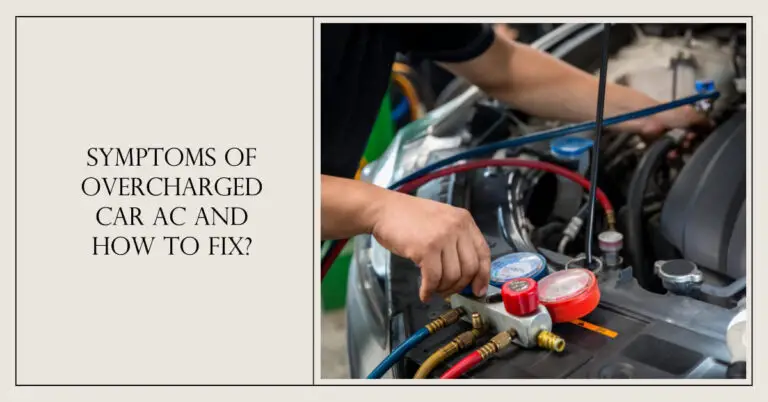Where are Mazda Cars Made? Manufacturing Plants & Models by Location

Mazda is one of the most popular Japanese automotive brands worldwide, with sleek styling, sporty driving dynamics, and fuel-efficient powertrains. But where exactly are Mazda cars and SUVs made?
The short answer is that Mazda vehicles are primarily manufactured in Japan, with additional production in Mexico, Thailand, China, and the United States through partnerships and joint ventures. Mazda owns and operates two plants in Japan, as well as an assembly facility in Mexico. Other models are produced through collaborative contracts across Asia and North America.
In this in-depth guide, we’ll explore all of Mazda’s major automobile manufacturing facilities around the globe. You’ll learn where each of the company’s popular models like the Mazda3, CX-5, CX-9, and MX-5 Miata are assembled. We’ll also take a quick look back at the history of Mazda’s car production journey over the past century.
Let’s shift into gear and see where Mazda calls home.
Table of Contents
Mazda’s Major Car Manufacturing Plants Worldwide
Mazda relies on a network of auto production plants in Japan, North America, and across Asia to manufacture their lineup of cars, SUVs, crossovers, and trucks. Here are the main facilities:
Mazda Hiroshima Plant – Japan
The Mazda Hiroshima plant located in Fuchū, Hiroshima Prefecture functions as the automaker’s headquarters and primary vehicle factory in Japan. Operations first began in 1920 as the Toyo Cork Kogyo Co. Over the decades, the facilities expanded massively to become Mazda’s central manufacturing hub.
Numerous models have been produced at the Hiroshima plant over the years, including the Mazda3, CX-30, MX-5 Miata, CX-5, and more. The factory currently has the capacity to build over 500,000 vehicles per year.
Mazda Hofu Plant – Japan
Mazda’s Hofu plant in Hofu, Yamaguchi Prefecture has served as an important part of the company’s production capabilities since it opened in 1982. Hofu plays a key role in manufacturing bigger vehicles like the CX-5 crossover, CX-8 and CX-9 SUVs, and Mazda6 sedan.
The Hofu factory has two production lines with a total annual capacity of over 180,000 units. Recent expansions will allow Mazda to build new large platform models like the CX-60, CX-70, CX-80, and CX-90 SUVs going forward.
Mazda Mexico Vehicle Operation (MMVO) – Mexico
Seeking to expand in the critical North American market, Mazda opened the MMVO plant in Salamanca, Mexico in 2013. The facility allows Mazda to cost-effectively produce certain models for sale in the U.S., Canada, and Mexico.
The Salamanca plant has an annual production capacity of 230,000 vehicles. Manufacturing currently focuses on the Mazda2 and Mazda3 sedans along with the CX-3 and CX-30 crossover SUVs.
AutoAlliance Thailand (AAT) – Thailand
AutoAlliance Thailand is a 50/50 joint venture between Ford Motor Company and Mazda Motor Corporation in Rayong Province, Thailand. The plant opened in 2012 and represents an important hub for compact car manufacturing.
Models produced at AAT include the Mazda2 subcompact and BT-50 pickup truck. The facility has capacity for over 100,000 units per year. Mazda builds vehicles at AAT for sale in Australia, New Zealand, and other Asia-Pacific markets.
Changan Mazda – China
Changan Mazda is a 50-50 joint venture between Changan Automobile and Mazda Motor Corporation based in Nanjing, China. The partnership dates back to 2012 and serves to manufacture Mazda-branded vehicles tailored for the Chinese market.
The Changan Mazda plant currently focuses on assembly of the Mazda2 and Mazda3 sedans. Phase 2 expansion plans will allow production of crossover SUV models as well. The factory has capacity to make over 200,000 Mazda vehicles per year moving forward.
Where Each Mazda Model is Manufactured?
Now that you understand Mazda’s major production hubs worldwide, let’s break down exactly where each of the company’s current car and SUV models are assembled:
Mazda2
The subcompact Mazda2 is built at two overseas joint venture facilities:
- AutoAlliance Thailand – For Australia, New Zealand, ASEAN region
- Changan Mazda – For the Chinese market
In addition, the Mazda2 for North America is manufactured at the Mazda Mexico Vehicle Operation (MMVO) plant.
Mazda3
The popular and sporty Mazda3 compact sedan and hatchback is produced at two key sites:
- Mazda Hiroshima Plant – Global production hub for most markets
- Mazda Mexico Vehicle Operation (MMVO) – North American market version
China also receives a locally-made variant from the Changan Mazda joint venture.
Mazda6
Mazda’s midsize Mazda6 sedan is exclusively manufactured at the company’s Hofu Plant in Yamaguchi Prefecture, Japan. This facility provides efficient rear-wheel drive production capabilities.
CX-3
The stylish subcompact CX-3 crossover SUV is assembled at Mazda’s Mexico plant (MMVO). It is built alongside the Mazda2 and Mazda3 for North American customers.
CX-30
Mazda’s popular entry-level compact crossover, the CX-30, rolls off the lines at two sites:
- Mazda Hiroshima Plant – Global production
- Mazda Mexico Vehicle Operation (MMVO) – North American market version
CX-4
The midsize CX-4 SUV is exclusive to the Chinese market. It is manufactured locally by the FAW Mazda joint venture in Jilin Province, China.
CX-5
The best-selling CX-5 compact crossover is Mazda’s workhorse model worldwide. It is built at three plants:
- Mazda Hiroshima Plant – Japan production for global markets
- Mazda Hofu Plant – Additional Japan capacity
- AutoAlliance Thailand (AAT) – Asia-Pacific models
CX-8
Mazda’s three-row midsize crossover, the CX-8, is currently only available in Japan and Australia. Manufacturing takes place at the Hofu Plant in Japan.
CX-9
The CX-9 is Mazda’s flagship SUV with up to three rows of seating. This large family hauler is built at two plants:
- Mazda Hofu Plant – Global production
- AutoAlliance (Mazda-Ford joint venture) – North American market version
CX-50
The all-new CX-50 crossover is the first model to be built at Mazda Toyota Manufacturing in Huntsville, Alabama (still under construction). It will also be produced at the Hofu Plant in Japan.
MX-5 Miata
The iconic Mazda MX-5 Miata roadster has been manufactured at Mazda’s Hiroshima Plant in Japan since 1989. This global two-seat sports car still represents the heart and soul of the brand.
Mazda MX-30
Mazda’s first all-electric crossover, the MX-30, entered production in early 2021 at the company’s Hiroshima Plant in Japan. The EV is currently only available in select European markets.
Mazda CX-60, CX-70, CX-80, and CX-90
Mazda recently announced four new SUV models – the CX-60, CX-70, CX-80, and CX-90. These larger premium crossovers will be built on the new rear-wheel drive platform and are expected to launch between 2022 and 2025. Manufacturing will take place at the Hofu Plant.
Brief History of Mazda Car Production & Manufacturing
To understand Mazda’s manufacturing footprint today, it helps to look back at the evolution of the company’s production capabilities over the decades:
- 1920 – Toyo Cork Kogyo Co. founded in Hiroshima, Japan. Begins as a maker of tools and cork.
- 1931 – Starts trial production of the Mazda-Go autorickshaw using a small 3-wheeled design.
- 1960 – Officially changes company name to Mazda Motor Corporation.
- 1968 – Begins export of the Mazda Cosmo Sport, their first passenger vehicle.
- 1970 – Opens the Ujina plant as a dedicated auto factory in Hiroshima.
- 1979 – Produces first front-wheel drive model, the Mazda RX-7.
- 1981 – Reaches major milestone of producing 1 million cars per year in Japan.
- 1984 – Opens additional plant in Hofu, Yamaguchi Prefecture. Begins production of the Mazda626.
- 1989 – Launches the legendary MX-5 Miata, which is still in production today.
- 1992 – Mazda and Ford form AutoAlliance joint venture and open Flat Rock, Michigan plant.
- 2012 – Partners with Changan Auto to open Changan Mazda plant in China.
- 2013 – Opens Mazda Mexico Vehicle Operation (MMVO) plant to produce cars for North America.
- 2015 – Celebrates production of 15 million vehicles since the company began manufacturing.
- 2017 – Annual global output exceeds 1.5 million units for the first time.
- 2021 – New U.S. joint plant with Toyota Motor Corporation announced in Huntsville, Alabama.
While founded in Japan, Mazda has embraced a global production model to build vehicles tailored for local markets. By investing in overseas joint ventures and partnerships, they aim to grow sales worldwide while controlling costs.
Future Outlook for Mazda’s Manufacturing Footprint
Looking ahead, Mazda will continue expanding their manufacturing capacity and capabilities in key regions to meet sales goals.
Major initiatives include:
- Ramping up production of next-gen rear-wheel drive models at Hofu Plant in Japan.
- Increasing Mexico capacity with potential new plant in Guanajuato state.
- Launching U.S. production at the Mazda Toyota joint venture plant in Huntsville in late 2021.
- Extending partnerships in Asia to cost-effectively produce entry models.
- Continuing investment and training to improve productivity and quality control at all plants.
As SUV and crossover sales increase globally, Mazda will adjust their production mix and locations to capture this growing product segment. While still anchored in Japan, expect more non-Japanese manufacturing plants to come online in the coming decade.
Conclusion
Whether you’re driving a Mazda2 subcompact or CX-9 family SUV, chances are your vehicle rolled off the assembly line at one of Mazda’s major production hubs in Japan, North America, China, or Southeast Asia.
Key takeaways on where Mazda cars are manufactured:
- Mazda’s main production facilities are in Japan (Hiroshima and Hofu), along with Mexico, Thailand, and China joint ventures.
- Flagship models like the CX-5, CX-9, and Mazda3 are made at multiple plants around the world.
- New larger rear-wheel drive models will primarily come from the Hofu Plant going forward.
- Overseas joint ventures allow cost-effective localized manufacturing for the Chinese and ASEAN markets.
- Mazda’s upcoming U.S. factory with Toyota in Alabama will produce crossover models starting in 2021.
With major investments in manufacturing capacity worldwide, Mazda aims to grow sales and continue improving the global production quality and efficiency of their fun-to-drive cars and SUVs.






